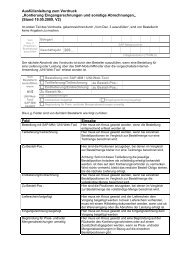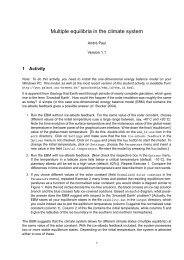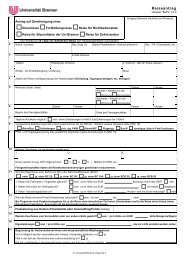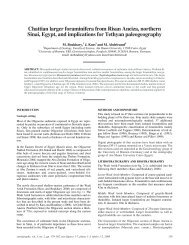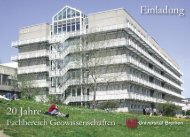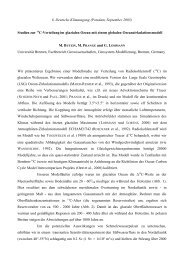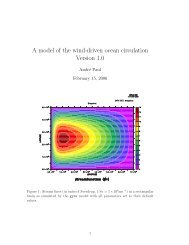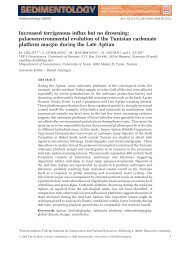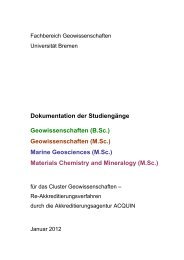160The Higgs bosonDetermination of upper and lower Higgs boson mass bounds from a chirallyinvariant lattice Higgs-Yukawa modelM. Müller-Preussker, K. Jansen, Institut fürPhysik, Humboldt-Universität zu Berlin; NIC, DESYZeuthenAbstract• The Higgs boson is a cornerstone of particlephysics, providing masses to all quarks, leptonsand the electroweak gauge bosons.• The search for the so far undetected Higgs bosonis the main target for the Large Hadron Colliderat CERN.• Theoretically, lower and upper Higgs boson massbounds can be computed but this must be carriedout in a non-perturbative fashion.• We compute such Higgs boson mass bounds bymeans of numerical s<strong>im</strong>ulations with lattice fieldtheory techniques.• Our results provide also the energy scale wherenew physics beyond the standard model of particleinteractions has to appear.The standard model of particle physics comprisesthe electroweak and the strong interactions. Theelectroweak theory, which unifies the electromagneticand the weak interactions within a chiralgauge theory, exploits the concept of spontaneoussymmetry breaking (here known as the Higgsmechanism) to provide masses for all quarks, leptonsand the weak gauge bosons (W, Z), postulatingthe existence of the Higgs boson. However,despite of the great success of the electroweakmodel, the existence of the Higgs boson has notyet been confirmed. Thus, there is presently alarge exper<strong>im</strong>ental effort at the Large Hadron Collider(LHC) at CERN which is dedicated to the discoveryof the Higgs boson as an essential cornerstoneof the electroweak model. On the theoreticalside, a prediction of the Higgs boson mass is notpossible, but at least lower and upper bounds canbe derived. These bounds are, in principle, of nonperturbativenature. Our work focuses therefore onthe Higgs boson mass bounds which we determinenon-perturbatively employing techniques of latticefield theory, in particular Monte-Carlo s<strong>im</strong>ulations.To this end, we neglect the gauge fields, whichcan be treated perturbatively, and study a Higgs-Yukawa model, which describes the interaction betweenthe scalar and the quark fields. Such studieshave already been performed in the past but theseworks were lacking the aforementioned most <strong>im</strong>portantchiral symmetry (the interchange of masslessleft- and right-handed quarks) and no consistentHiggs-Yukawa theory could be established onthe lattice.However, recent developments in lattice fieldtheory have led to a realization of chiral symmetryon the lattice. We consider a chirally invariant latticeHiggs-Yukawa model based on the so-calledNeuberger overlap operator. With this setup, wewere able to provide fully non-perturbatively determinedupper and lower Higgs boson mass boundswhich are of direct <strong>im</strong>portance for the Higgs bosonsearch at the LHC.Our work concerning the Higgs boson massbounds have appeared in a number of publications,[1],[2],[3],[4] and contributions to international conferences.Besides the physical results, describedbelow, it needs to be stressed that a large efforthas been undertaken by us to <strong>im</strong>prove the performanceof the algorithm employed for the numericals<strong>im</strong>ulation of the model. It goes beyond the scopeof this article to discuss these <strong>im</strong>provements in detail,they can be found in the Ph.D. work of P. Gerhold,ref. [3], but it should be mentioned that theyled to a factor of 10-100 acceleration of the s<strong>im</strong>ulations.This has been an essential step to derivethe desired Higgs boson mass bounds.A most <strong>im</strong>portant role in determining the lowerand upper bounds of the Higgs boson mass isplayed by the self-interaction of the Higgs field. Itis described by a 4-point interaction multiplied by aquartic coupling λ. The value of λ has to be positivein order to have a stable theory. This leads to alower bound of the Higgs boson mass at a value ofλ = 0. On the other hand, the quartic coupling cannotexceed a value of λ = ∞ which then leads toan upper bound on the Higgs boson mass. Computingthe Higgs boson mass at λ = 0 and λ = ∞were, in fact, the strategies for deriving the desiredHiggs boson mass bounds 1 .In quantum field theories, a cut-off has to be introducedin order to render the calculations in agiven theory finite. Of course, in the end, such anunphysical cut-off has to be removed from the theory.In the here considered Higgs-Yukawa model,the removal of the cut-off leads to a peculiarity:with increasing cut-off, the strength of the Higgsself-interaction d<strong>im</strong>inishes and when the cut-off is1 It has to be remarked that the actual arguments are more involved and are usually refered to as vacuum instability for the lowerand as triviality for the upper mass bound.Physik
161Higgs boson mass bounds [GeV ]70060050040030020010005001000 1500 2000 25003000Cutoff Λ [GeV ]Figure 1: The final result on the Higgs boson mass bounds. The solid lines are predictions from perturbation theory;the red curve denotes the effect of three fermion generations with a physical top quark mass of 175 GeVand a physical bottom quark mass of 4.2 GeV.removed (it assumes an infinitely large value) theself-interaction vanishes completely and leaves atrivial, non-interacting theory behind. Therefore, itonly makes sense to study the theory with a cut-offin place and to investigate the dependence of theHiggs boson mass bounds as a function of the cutoff.This cut-off dependence is the main result ofour work and it is shown in fig. 1.In our model, there are mass-less modes whichlead to large finite size effects of physical quantities.We have therefore performed a careful analysisof these effects by performing s<strong>im</strong>ulations onvarious size lattices up to 40 4 number of points.Hence we have about O(10 Million) degrees offreedom in the problem. The data shown in fig. 1are then obtained after an extrapolation to an infinitevolume is performed.In fig. 1, the area between the lower and the upperHiggs boson mass bounds gives directly theallowed range of Higgs boson masses consistentwith the electroweak standard model. However, thegraph can also be interpreted in an alternative way:if we assume that the Higgs boson mass has beendetermined exper<strong>im</strong>entally at the LHC, we can directlyread off the max<strong>im</strong>al value of the cut-off upto which the standard model is valid. For example,if the Higgs boson mass would be found at around600 GeV, the max<strong>im</strong>al cut-off is about 1.5 TeV. Realizingthat the value of the cut-off is just a measurefor the scale where new physics beyond the standardmodel has to appear, such a scenario wouldlead then to the exciting conclusion that a new kindof physics will be detected at the LHC.We conclude this contribution by mentioning thatwe presently investigate the resonance parametersof the Higgs boson which will provide additional informationon the Higgs sector and which is another<strong>im</strong>portant information for Higgs boson searches atthe LHC. In addition, we are looking at effects of apossible heavy 4th quark generation on the Higgsboson mass bounds. First results [4] indicate thatwhile the upper Higgs boson mass bound is onlyshifted by about 20%, the lower mass bound isshifted almost by a factor of ten. This can providevery stringent bounds on the mass of such a heavynew fermion generation.More Information1. P. Gerhold, K. Jansen, Lower Higgs boson massbounds from a chirally invariant lattice Higgs-Yukawa model with overlap fermions, JHEP0907 (2009) 025.2. P. Gerhold, K. Jansen, Upper Higgs bosonmass bounds from a chirally invariant latticeHiggs-Yukawa model, JHEP 1004 (2010) 094.3. P. Gerhold, Upper and lower Higgs bosonmass bounds from a chirally invariant latticeHiggs-Yukawa model, PhD Thesis, HU Berlin,[arXiv:1002.2569 [hep-lat]].4. P. Gerhold, K. Jansen, J. Kallarackal,Higgs boson mass bounds in the presenceof a very heavy fourth quark generation,[arXiv:1011.1648 [hep-lat]], to appear in JHEP.FundingGerman Research Foundation (DFG), TelekomFoundationPhysik



